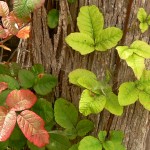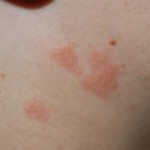Poison Ivy
Here in temperate Coastal California people and their pets get into poison oak all year long. However, there is always more problems from it between spring and fall when everybody (both people and their pets) is outdoors.
Fact #1
The allergic rash of poison oak and poison ivy (Toxicodendron dermatitis) comes from an allergic reaction due to contact with the urushiol allergen. This allergen is found in the family of plants called Anacardiaceae which include:
- Poison ivy
- Poison oak
- Poison sumac
- Japanese lacquer tree
- Cashew nut tree (the allergen is in the nut shell)
- Mango (the allergen is in the fruit rind, leaves, and sap)
- Rengas tree
- Indian marking nut tree
- Ginkgo (the allergen is in the fruit pulp)
- Brazilian pepper tree, also called Florida holly
- Poisonwood tree
If you are allergic to poison oak or poison ivy then assume you are allergic to all of these plants and/or plant parts.
Fact #2
The rash begins with contact to the urushiol allergen:
In the case of poison oak and poison ivy, the allergen typically comes into direct contact your skin when you:
- touch the plant directly
- touch something with the oil on it (e.g. your cat that just ran through poison oak, your kids’ clothing when they’ve been out playing in the poison oak ,etc).
Blisters from the rash do not contain the oil and so they are not contagious! Really!! Once the oil is washed off the skin, it is gone and your skin, no matter how bad it has broken out, is not contagious (more on that below).
Allergic urushiol oil can also come into contact with your skin when it is spread in the air by smoke from the burning of the plants in the Anacardiaceae family, and in the wind from weed-whacking the plants.
One caveat, in highly allergic people, eating the allergens will cause a rash either around the buttocks or over the entire body from a systemic allergic reaction. Some homeopathic remedies contain Rhus Tox, the same allergen, and I’ve seen some wild total-body allergic rashes in patients who have poison oak and decide to “support their immune system” from taking Rhus Tox. Don’t do it!
Why the rash seems contagious.
It’s because the rash usually starts showing up within 2 days after exposure, but it continues to evolve for upwards of 2 weeks. It’s not because it is contagious and you keep getting it from touching your involved skin. It’s because:
- The more allergic you are, the faster the rash shows up.
- Parts of your skin that have had the rash before react faster.
- Parts of your skin that had a big dose of plant allergen oil react faster.
- Parts of your skin that never had the rash and that got low dose exposure react much slower, sometimes not showing the rash for a week or two.
Again, it’s worth repeating, it is not because you touched the rash on other parts of your skin and it “spread.” Once you’ve washed the plant oil off of your skin your skin is no longer contagious. That said, you can get re-exposed from contaminated pets, clothing, etc. that still have the oil on them.
The more allergic, and the bigger the dose of allergen oil you touched, the more dramatic the rash. The rash can vary from a little patch of itchy, scaling skin to giant blisters that weep and ooze on plaques of intensely swollen, red, and itchy skin.
What can you do to prevent getting the rash of poison oak or ivy?
 Learn to identify the poison oak and ivy plants and then avoid them. Poison oak and ivy plants look very similar. They both have three leaflets arising from a node on the stem. Wikipedia has a very detailed description to help you learn how to identify poison oak and ivy.
Learn to identify the poison oak and ivy plants and then avoid them. Poison oak and ivy plants look very similar. They both have three leaflets arising from a node on the stem. Wikipedia has a very detailed description to help you learn how to identify poison oak and ivy.
Wash your skin with soap and water within five minutes after coming into contact with the oil. This can remove the oil so that it can’t be absorbed by your skin. You can actually prevent the rash all together, but you have to be fast and thorough, giving your skin a good washing.
Wash anything that might be contaminated with the oil, including pets, clothing, tools, and toys – anything that touched the plant oil. Give it a good think and try to find everything that might even remotely have gotten contaminated, and wash it!
How do you treat poison oak or poison ivy once the rash starts?
As soon as you start to develop the itchy rash:
- Apply cortisone cream. You may need a prescription from your doctor since the over the counter hydrocortisone isn’t very strong.
- Keep itchy skin cool to help relieve itch and prevent further inflammation. Hot water may soothe temporarily, but it will make the itching worse overall. Sometimes a cool bath with Aveeno Oatmeal powder is just the thing to help relieve itch.
For weeping blisters:
- Mix a mild vinegar solution made of one tablespoon white vinegar in one pint cool water, wet a cloth, and apply to the blisters for 10-15 minutes four times a day. This helps draw out the fluid and dry the weeping.
- Apply Calamine Lotion with or without doing the vinegar soaks. This also helps to dry the weeping. I particularly like Calamine with Pramoxine, which is an additional anti-itch medicine that provides relief. Avoid Calamine Lotions with antihistamines (Benedryl, diphenhydramine, etc.) or topical anesthetics (“cains” such as lanocaine and benzocaine) because they can cause an allergic reaction that looks exactly like poison oak/ivy.
To relieve itching:
- Stay cool. Again, cool skin itches less.
- Take oral antihistamines (if it’s safe for you to do so), like Benadryl, according to directions. It can help to relieve itch.
Again, avoid topical antihistamine and topical anesthetic products with “cains” (lanocaine, benzocaine) because they can cause yet another allergic rash and you won’t know where your poison oak ends and your allergic drug rash starts.
For severe reactions see your doctor for oral cortisone or an injection of it.
